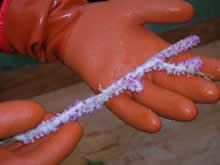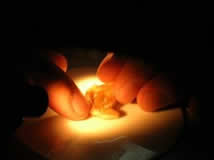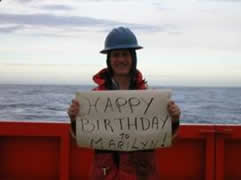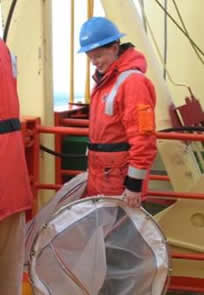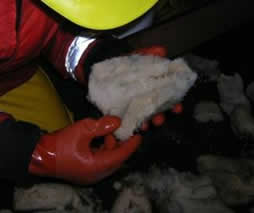
 |
| Academic Departments | Student Services | Alumni | Research | Outreach | Diversity |
| 1 | 2 | 3 | 4 | 5 | 6 | |
| 7 | 8 | 9 | 10 | 11 | 12 | 13 |
| 14 | 15 | 16 | 17 | 18 | 19 | 20 |
| 21 | 22 | 23 | 24 | 25 | 26 | 27 |
| 28 | 29 | 30 | 31 |
| 1 | 2 | 3 | ||||
| 4 | 5 | 6 | 7 | 8 | 9 | 10 |
| 11 | 12 | 13 | 14 | 15 | 16 | 17 |
| 18 | 19 | 20 | 21 | 22 | 23 | 24 |
| 25 | 26 | 27 | 28 | 29 | 30 |
Daily Journals
May 15, 2006
We are in calm seas and the albatrosses (Wandering and Black-browed), giant petrels and Cape petrels are surrounding us, especially when we are going very slowly while doing over-the-side operations. Are they looking for food from us? Whatever gave them that clue, out here in the middle of nowhere?? Perhaps they know a ship will eventually throw something over that might make a meal – and we do put the dredge leftovers back into the water when we’re done. I’d like to think they just like our company.
I visited the Bridge today, and spoke with the ship’s Captain, Marty Galster. He showed me the planned course of this cruise on a variety of charts, in different levels of detail. It’s very orderly and somewhat formal in the Bridge as you might imagine, and information is easily accessed because of its organization and layout. The person at the helm is always in tight communication with the Chief Scientist about the Plan for the Day. The Captain or one of the ship’s Mates steer the ship, and they each have 4-hour ‘shifts’ (twice a day) to cover that job. During a shift at the helm, they oversee and maneuver around several deck operations. Although they’re busy covering their 8 hours at the helm, you might see any of the captains, as well as other ship’s crew, checking out the labs and genuinely showing interest in what we’re seeing, or otherwise getting to know the guests on the ship. It is very much a ‘working together’ environment, and this makes it truly pleasant to live with relative strangers in relatively tight quarters. Getting to Know You MPC Jon Alberts has a highly visible and responsible position on this ship, too. As Marine Projects Coordinator and top Raytheon staff person on board, his job is to interface between the ship’s crew and the science personnel. But he also acts on behalf of the National Science Foundation (NSF), the agency that granted the money for Ken Halanych and Rudi Scheltema to perform this course of study. For NSF, Jon sees that the work gets done with the greatest amount of efficiency and necessary attention to safety. Jon ‘greases the wheels’ above decks. The rest of the ship’s crew members are employees of the ship’s mother company, Edison-Chouest. Therefore, you can see that Jon has to coordinate several teams, and be everything to everybody without burning up on re-entry. Back to the Science The Plankton Tow routine is settling in nicely, with able leaders as mentors and co-conspirators to whip this team into shape. Actually, there is enough inherent skill in the group to not need any ‘whipping’. And the samples being brought in are already making the rounds from dish to camera to preserving jars.
Tonight the Blake trawl’s net was filled to the max – primarily with sea sponges. I couldn’t imagine what was in that net, as it took 3 men several hoists to get it from the deck into the sorting box. But as you know, sponges are just that much heavier when they’re filled with water! (Well, that 30-pound rock didn’t help much, either.) There were several specimens with dimensions of probably 16x3 inches – so Ken instructed everyone to perform ‘cavity searches’. In other words, the sponges were opened up because their hollow centers are safe havens for many species of animals in the sea. Indeed, there were many more critters hiding in the soft caverns of the sponge bodies.
So, don't hesitate to email questions to us at outreach@lmg.usap.gov
…yielded this.
|
Longitude/Latitude: S53° 47.141’ W61° 48.656’ Temperature: Wind: NE at 16.6kn Air Temp: 8.6°C Wind Chill: -0.4°C Menu: Ham, chicken, mac & cheese, beans; Meatloaf, pasta w/ clam sauce, carrots, cauliflower and fresh salad; Pecan pie and cookies.
Photos: Station 3, May 15, 2006
‘Cavity search’ on sea sponges
|
- Alabama Agricultural Experiment Station
- Alabama Cooperative Extension System
- Auburn Online Community
- Bookstore
- Center for Diversity
- Crisis/Incident Assistance
- Diversity and Multicultural Affairs
- Financial Aid
- Hotel and Conference Center
- Jule Collins Smith Museum of Fine Art
- Medical Clinic
- Southeastern Raptor Center
- Special Reports
- Students w/ Disabilities
- Theatre
